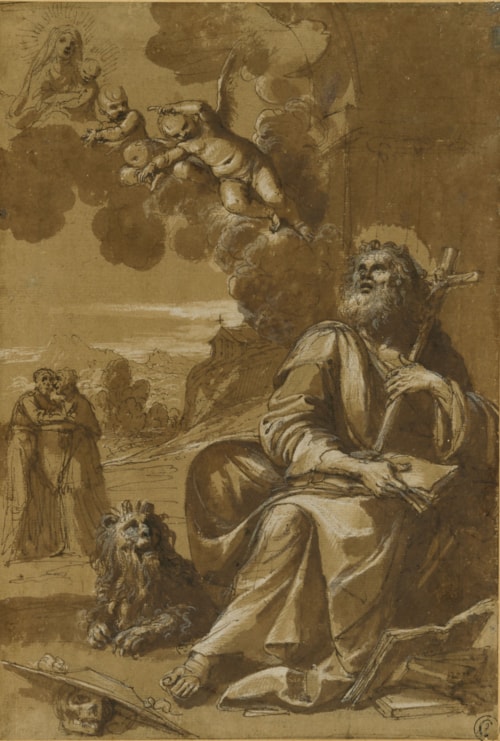
Francesco BRIZIO
Bologna c.1574 - Bologna 1623
Biography
Francesco Brizio was a pupil of Bartolomeo Passarotti in Bologna before transferring at the age of eighteen to the Accademia degli Incamminati, the Carracci academy in Bologna. He learned the art of engraving from Agostino Carracci and developed into a talented printmaker, producing a number of engravings after works by Ludovico and Agostino Carracci, Parmigianino and Correggio. Following Agostino’s departure for Rome in 1597, Brizio seems to have taken over his printmaking business in Bologna. At the same time he began to work closely with Ludovico Carracci, whom he assisted on some major public commissions, notably the decoration of the Palazzo Fava in Bologna between 1598 and 1600 and the cloister of the monastery of San Michele in Bosco, completed in 1605. Brizio was given charge of the Carracci studio when Ludovico went to Rome in 1602, and among his earliest significant independent commissions was the fresco decoration of the Negri-Formagliari chapel in the Bolognese church of San Giacomo Maggiore, completed in 1602. Together with Leonello Spada and Lucio Massari, Brizio worked on the fresco decoration of the Palazzo Bonfioli Rossi in Bologna and the Oratorio della Santissima Trinità at Pieve di Cento. Other churches in Bologna decorated with frescoes, paintings or altarpieces by Brizio include San Colombano, San Domenico, San Martino Maggiore, San Michele in Bosco, San Petronio and San Salvatore. Brizio painted decorative frescoes for other villas and palaces in Bologna and the surrounding area, and also worked in Modena and Cento. Towards the end of his life he worked on an extensive cycle of fresco decorations in the Palazzo Orlandini-Marescalchi.
In his brief account of Brizio’s career, the 17th century Bolognese biographer Carlo Cesare Malvasia noted the artist’s small-scale works in particular, which he praised for their ‘delicacy and grace’ (‘delicatezza e leggiadria’). By the end of the 18th century, however, Brizio had been almost forgotten as a painter, and when he was occasionally noted in documents it was mainly for his work as an engraver. It is only in the last two or three decades that Brizio’s work as a painter and draughtsman has been the subject of renewed scholarly attention.
The largest extant group of drawings by Brizio, amounting to around nine or ten sheets, is today in the Koenig-Fachsenfeld collection at the Staatsgalerie in Stuttgart. Other drawings by the artist are in the collections of the Harvard University Art Museums in Cambridge (MA), the Hessisches Landesmuseum in Darmstadt, the National Gallery of Scotland in Edinburgh, the Uffizi in Florence, the British Museum, the Courtauld Galleries and the Victoria and Albert Museum in London, the Staatliche Graphische Sammlung in Munich, Christ Church in Oxford, the Louvre in Paris, the Biblioteca Nacional in Rio de Janeiro, the Fondazione Giorgio Cini in Venice, the Royal Collection at Windsor Castle, and elsewhere.


